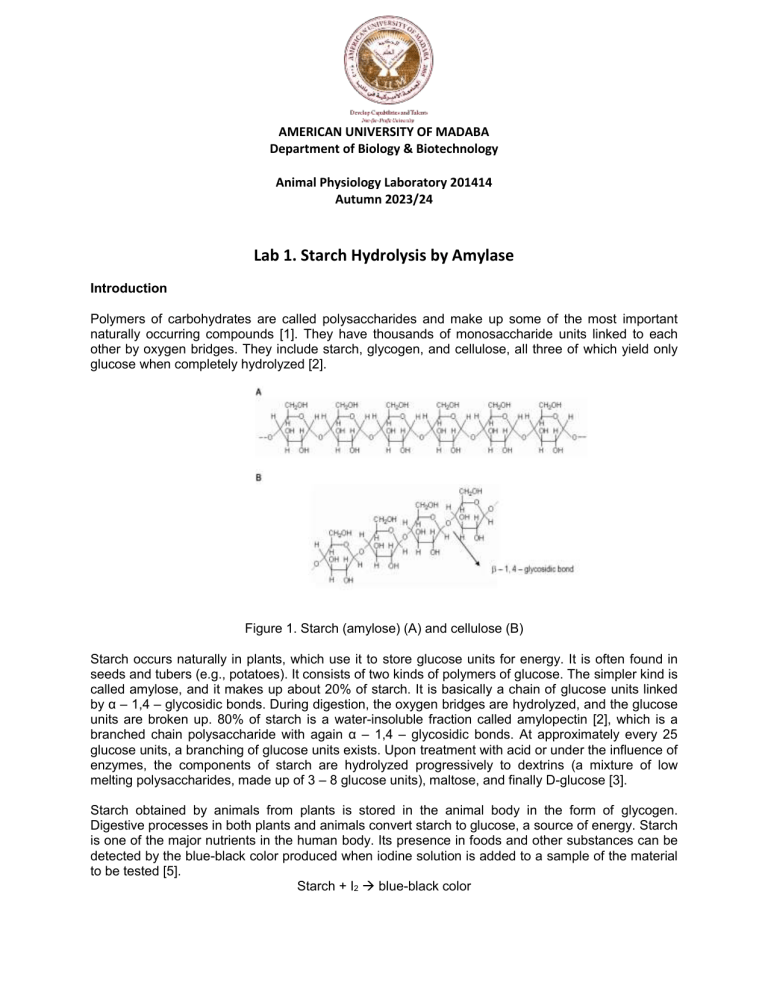
AMERICAN UNIVERSITY OF MADABA Department of Biology & Biotechnology Animal Physiology Laboratory 201414 Autumn 2023/24 Lab 1. Starch Hydrolysis by Amylase Introduction Polymers of carbohydrates are called polysaccharides and make up some of the most important naturally occurring compounds [1]. They have thousands of monosaccharide units linked to each other by oxygen bridges. They include starch, glycogen, and cellulose, all three of which yield only glucose when completely hydrolyzed [2]. Figure 1. Starch (amylose) (A) and cellulose (B) Starch occurs naturally in plants, which use it to store glucose units for energy. It is often found in seeds and tubers (e.g., potatoes). It consists of two kinds of polymers of glucose. The simpler kind is called amylose, and it makes up about 20% of starch. It is basically a chain of glucose units linked by α – 1,4 – glycosidic bonds. During digestion, the oxygen bridges are hydrolyzed, and the glucose units are broken up. 80% of starch is a water-insoluble fraction called amylopectin [2], which is a branched chain polysaccharide with again α – 1,4 – glycosidic bonds. At approximately every 25 glucose units, a branching of glucose units exists. Upon treatment with acid or under the influence of enzymes, the components of starch are hydrolyzed progressively to dextrins (a mixture of low melting polysaccharides, made up of 3 – 8 glucose units), maltose, and finally D-glucose [3]. Starch obtained by animals from plants is stored in the animal body in the form of glycogen. Digestive processes in both plants and animals convert starch to glucose, a source of energy. Starch is one of the major nutrients in the human body. Its presence in foods and other substances can be detected by the blue-black color produced when iodine solution is added to a sample of the material to be tested [5]. Starch + I2 blue-black color Proteins that catalyze chemical reactions are called enzymes. Non-biological catalysts work at wide ranges of temperature and pHs, whereas enzymes must work in mild conditions in cells, between 32℃ and 40℃ and at a pH between 6.5 and 7.5 [6]. Enzymes are highly specific both in the reaction catalyzed and in their choice of reactants, which are called substrates. An enzyme usually catalyzes a single chemical reaction or a set of closely related reactions. To catalyze a reaction, a substrate must have a matching shape to the active site of the enzyme [2]. The products of the reaction then leave the active site, freeing it up for more similar reactions to take place. Amylase, an enzyme secreted by the salivary glands and the pancreas, rapidly hydrolyzes amylopectin and amylose [2]. Salivary amylase, which is also known as ptyalin, begins the polysaccharide digestion in the mouth. The digestion process is completed in the small intestine by pancreatic amylase [5]. Spectrophotometry A solution appears colored because it absorbs certain wavelengths of light in the visible spectrum and reflects the others [7]. A spectrophotometer measures the transmission or absorption of liquids or solids as a function of wavelength [8]. Biologists use the spectrophotometer for two different purposes: 1. To determine the absorption spectrum of a pure substance in solution. 2. To determine the concentration of a solution. The spectrophotometer shines light at a set of colors (at different wavelengths) through the sample and measures the percent of light that is absorbed by the sample. By comparing this amount with the graph constructed with known concentrations (calibration curve), the concentration of the unknown solution can be determined [9]. A spectrophotometer consists of a white light source (light of all visible wavelengths), a prism or diffraction grating that separates the light into different wavelengths, a slit through which a narrow beam of the desired wavelength passes (the incident light- I0), a sample solution holder, a photosensitive tube which measures the energy of light transmitted through the solution (I), and a recording device that displays the amount of transmitted light energy digitally or on a dial. Figure 2: Schematic diagram of the components of a spectrophotometer. The arrows indicate the pathway of light. Transmittance is the ratio of the transmitted light energy (I) to the incident light energy (I0); percent transmittance is 100X ratio (I/I0). Transmittance, however, is not proportional to solute concentration, so it is usually converted into absorbance which is proportional to solute concentration. Digital spectrophotometers have readouts for both percent transmittance and absorbance, but the absorbance is measured always [7]. Transmittance (T) % = (I/I0) x 100 Absorbance (Abs.) = log 10 (100 / T%) Equipment and Reagents Instruments - Spectrophotometer - Test tubes - Test tube rack - 250 mL beaker Disposables Plastic cuvettes Droppers - Water bath - Hot plate Buffers and Chemicals - Human salivary enzyme - Starch solution, 20 g/L - Iodine reagent - Phosphate buffer saline, pH 4, 7, and 9 - Ice Procedure A. Preparation of 20 g/L starch solution 1. Mix 20 g of soluble potato starch in approx. 50 mL of cold water. 2. While stirring, add the slurry to approx. 900 mL of gently boiling water in a large beaker. 3. Mix well and cool the gelatinized starch solution to room temperature. 4. Add more water to bring the total volume to 1 liter. 5. Put a few drops of the starch solution to a test tube. Add 1 drop of the iodine reagent and see that a deep blue color is developed. The blue color indicates the presence of starch in the solution. B. Preparation of enzyme solution Dilute 0.5 mL of your saliva with 9 mL 0.5% NaCl solution. C. Effect of pH 1. In three different test tubes, add 2.5 mL of the PBS solutions with a pH of 4, 7, and 10 to 2.5 mL of the 20 g/L starch solution. The resulting solution should contain 10 g/L of starch in a buffered environment. 2. Start the enzymatic digestion process by adding 1 mL of human salivary enzyme solution to each test tube; shake and mix. 4. Let the hydrolysis reaction proceed for 30 minutes at 37 ℃. 5. Add one drop of iodine to the reaction. Shake and mix. The solution should turn deep blue if there is any residual, unconverted starch present in the solution. The solution is brown-red colored for degraded starch. 6. Measure the absorbance with a spectrophotometer at 620 nm. D. Effect of Temperature 1. Prepare the 3 test tubes with 2.5 mL of the 20 g/L starch solution added to an equal volume of pH = 7.0 PBS. This results in a working starch concentration of 10 g/L. 3. Allow the temperature of each of the starch solutions to come to equilibrium with that of the Ice, the 37C water bath, and the 90C beaker. 4. Add 1 mL of human salivary enzyme solution to each of the thermostated test tubes to start the reaction. 5. After 30 minutes, analyze the starch content by following the procedures outlined above. References 1. Morrison, R.T., and Boyd, R.N., Organic Chemisty, 6th Ed., Prentice Hall, New Jersey, 1992 2. CHEMystery, Organic Chemistry, Carbohydrates, 2003 http://library.thinkquest.org/ 3. Stryer, L., Biochemistry, 4th Ed., W.H. Freeman Company, New York, 1999 4. Perona, M., Analysis of Foods for Starch and Vitamin C, 2000 http://science.csustan.edu/perona/2000/Exp8/bkg.htm 5. Starch, The Columbia Electronic Encyclopedia, Columbia University Press, 2003 http://reference.allrefer.com/encyclopedia/S/starch.html 6. Amylase, GreenWood Health Inc., 2003 http://greenwoodhealth.net/np/amylase.htm 7. Campbell, M., Introduction to Spectrophotometry, Davidson College, 2000 http://www.bio.davidson.edu/Courses/Bio111/Bio111LabMan/Lab%201.html 8. Dzierba, A., Spectrophotometer, Indiana University, 2003 http://dustbunny.physics.indiana.edu/~dzierba/P360n/KPAD/Exps/Spectro/spectro.html 9. Heitholt, J., Spectrophotometry, Texas A&M University, 2000 http://www7.tamu-commerce.edu/agscience/clasnote/pls497/SpecLecture Report Question 1. A. Write down the enzyme activity (absorbance) for each pH. pH Abs. B. Does the result reflect the true physiological effect of pH on amylase? C. Explain your results. Question 2. A. Write down the enzyme activity for each temperature used. Temperature Abs. B. Does the result reflect the true physiological effect of pH on amylase? C. Explain your results.






